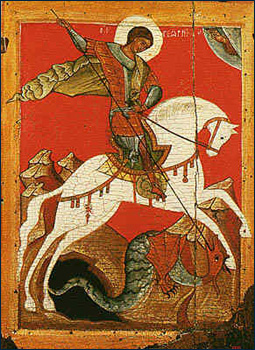 Image via Wikipedia
Image via WikipediaOn an island known to the Greek people as Prinkipo, just outside of Costantinopole, a festive air reigns every year on Saint George day, which is usually celebrated on April 23 (unless it coincides with Easter). At the base of the hill thousands of Muslim pilgrims buy charms and trinkets designated for whatever they may be praying for: health, love, marriage, children and make their way to the Church to ask for favours from Saint George.
Some come barefoot up the hill which takes about 30 minutes to climb to the Monastery, others come with offerings of oil, candles, and sugar so that their lives may be sweet. Some do not speak as they climb up to the Monastery until they kiss the icon of St. George. They follow the services with hands lifted in the air holding lit candles. Many will return later to thank St. George, who heard their prayer and granted, as they claim, their desire.
This historic Monastery of Saint George Koudounas, on Prinkipos Island, was according to tradition built by the Byzantine Emperor Nikephoros Phokas in 963 AD. A miraculous icon of St. George was brought here from the Monastery of Peace, which was founded by Emperor Justin II, in Athens at that time. The Monastery was later sacked in the Fourth Crusade. Then in 1302 the pirate Giustiniani plundered all the buildings and monasteries of the island. Not wanting their holy icon stolen by the Franks, the monks hid the icon under the earth and place the holy altar above it. The miraculous icon however was lost for many years. Later, St. George appeared to a shepherd in a dream and told him where to find his icon. When he approached the area, he heard the ringing of bells, and having unearthed the icon, found it decorated with bells. This is the source behind the epithet “Koudouna” which means “bells”. The Monastery was later attached to Hagia Lavra in Kalavryta, and eventually to the Patriarch of Constantinople.
St George, the 'warrior saint', may be puzzled by all of this. Known for smiting the dragon he offered inspiration to belligerent Crusaders, but for countless years on Büyükada he has brought members of different faiths together. Every year, as at many times during the year, their prayers in different languages will again intermingle and rise heavenwards.
The miracles of the Saint are many, not only towards Christians Romans, who approached always with great reverence (in olden times there wasn’t a Christian family which had not visited Koudouna at least once a year), but towards everyone without exception, who approach his grace with faith. Thus there is a great mass of people who come from other faiths from throughout Turkey. The pilgrims number about 250,000 a year, the majority being muslim Turks.
It is because of the great respect for St. George that none of the Orthodox churches dedicated to him in Turkey have been demolished, as well as churches dedicated to the Theotokos who also is greatly respected by Muslims.






